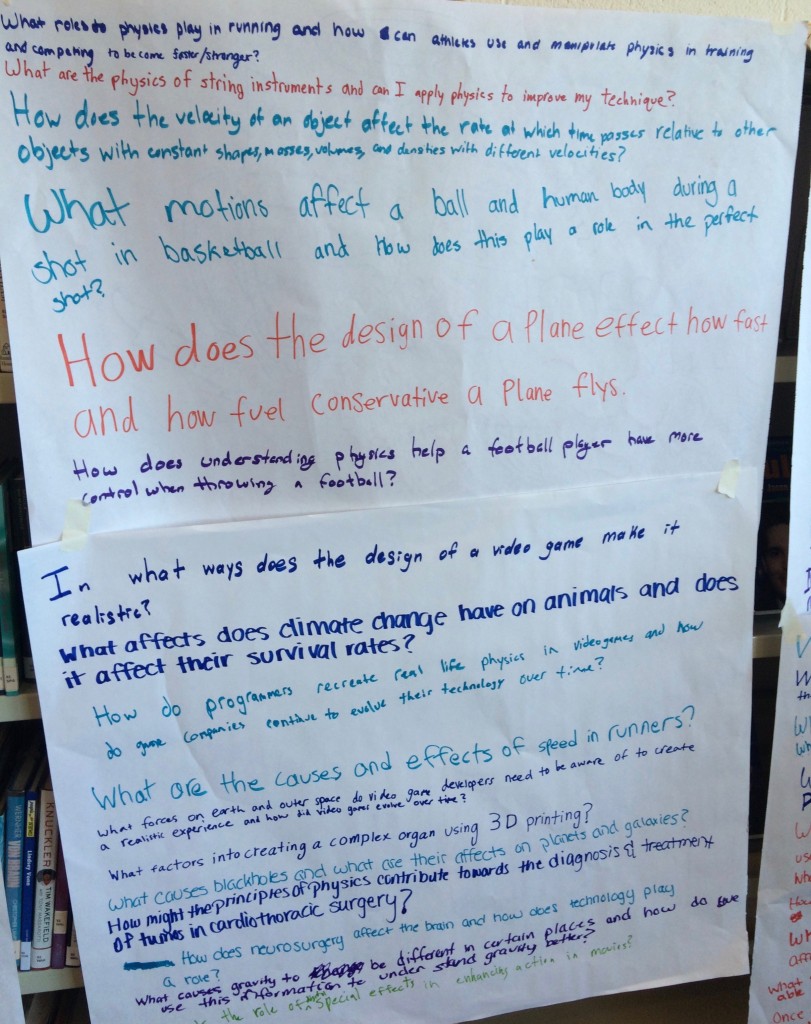

This week we are talking about student questions, what questions students come up with within the context of a GID unit, and how they relate to and address the content of the curriculum. With these posts, we hope to inspire you to let go and structure your learning using the GID process so that students are doing the asking.
Let’s start with the end in mind. I’ll begin with high school so that you can get a feel for the level of questioning that occurs in academic content area courses in high school. Then I’ll work down through middle school onto elementary to show you how those questions look as well.
So, we begin at Westborough High School in Westborough, Massachusetts. Anita Cellucci and Kathleen Stoker are a GID learning team extrodinare. Anita, just this week, was named as a finalist for the librarian of the year award by SLJ and Scholastic! Congratulations to one of our best! And her teammate, Kathleen teaches a course on Psychology and Literature that she described on our blog in April. Their work together is what every collaboration aspires to do, their collaborative work raises above and beyond what either of these two could do on their own.
In their course that was expertly designed using the GID process, students had questions that were personally relevant, interesting, and were centered within the content of the course. The process of Guided Inquiry support your learning team to get students there. As you read these questions- see if you can
Here they are:
“How are veterans affected by PTSD and what are some ways they are treated?”
“What is stress? What physical and emotional impacts are there due to stress and what are ways to cope with it?”
“How does music therapy affect an individual mentally and physically, and how can using music therapy benefit the patient over other types of therapies?”
“How are students affected by sleep deprivation and what can schools to do to help students?”
“How does art therapy help in ways that other therapies do not?”
“In what ways can technology be addictive and how can this problem be addressed?”
Through examining these questions, the students connections to their own experiences jump out at you, their interests are clear, and the content is also evident even without knowing the syllabus for Kathleen’s Psychology in Literature class. It also seems that they had some idea that there were therapies that could help people, and most students were interested in knowing about the problem as well as the solutions that exist for that problem. Pretty exciting topics and worth sharing with a wider audience, don’t you think!? To read more about this unit, read Kathleen’s posts from April. They’ll be doing this unit again this year, so maybe we’ll get a round 2 of blog posts to hear how it went this year! 😉
The next unit offers us a little sneak peek into the book coming out in December as this unit is described in detail there! The book is Guided Inquiry Design in Action: High School. In it we have four units of study just like we did in the Middle School book! The unit Anita and Marci did was described here in Marci and Anita’s posts. They worked together on a Physical Science unit for ninth grade. Through the process they built a large inquiry community with the many sections of this course and they met in the large library 2 sections at a time. When it came to Identify the students wrote their questions on chart paper that were posted around the library so that all the students could see the variety of interests across all groups in the larger InquiryCommunity. Here’s a picture of one of the charts.
Some of the students questions –
What is the role of gravitational force in our everyday lives? And, in what ways can it be changed into a different form of force?
How do different types of media effect sound waves and how does this relate to communication?
How are Newton’s laws related to earth and in what ways is this information used to explore other planets?
In what ways does the architecture of a building effect it’s stability in the wind?
What is the role of force and friction in field hockey?
How can a figure skater improve by studying physics?
Again, with these questions you can see a direct tie to the content of physical science and physics. Students have a real desire to know the answer to these questions. The questions connect to their lives and are bridges to the Third Space. There is higher order thinking going on as well as interpretation and application of content from the first three phases evidenced in these questions.
I like how a few of them use the beginning frame of “In what ways… Or what role does…” Notice, we often say “why questions” are the most open ended, but “what questions” are really useful when students know enough background knowledge to ask a “what question” that will take them deeper into the content, as these do here.
So this sample of REAL questions are examples to you, to calm your fears of students asking off the wall questions that won’t relate to the content of the course. And to help you trust the process, because when you design units using EVERY phase of GID, students identify wonderful useful questions.
Thanks again to Anita, Marci and Kathleen for sharing their work with me and all of us!
More on middle school questions in the next post!
Leslie Maniotes, PhD
Author of the Guided Inquiry Series